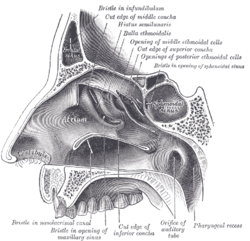

| Sphenoid sinus | |
|---|---|

Lateral wall of nasal cavity; the three nasal conchæ have been removed. (Sphenoidal sinus visible at upper right, in dark circle.)
| |

Nose and nasal cavities. (Sphenoid sinus labeled at upper right.)
| |
| Details | |
| Nerve | Posterior ethmoidal nerves, and orbital branches of the pterygopalatine ganglion |
| Identifiers | |
| Latin | sinus sphenoidalis |
| MeSH | D013101 |
| TA98 | A06.1.03.003 |
| TA2 | 3178 |
| FMA | 54683 |
| Anatomical terms of bone | |
The sphenoid sinus is a paired paranasal sinus occurring within the body of the sphenoid bone. It represents one pair of the four paired paranasal sinuses.[1] The pair of sphenoid sinuses are separated in the middle by a septum of sphenoid sinuses. Each sphenoid sinus communicates with the nasal cavity via the opening of sphenoidal sinus.[2]: 500 The two sphenoid sinuses vary in size and shape, and are usually asymmetrical.[3]

On average, a sphenoid sinus measures 2.2 cm vertical height, 2 cm in transverse breadth; and 2.2 cm antero-posterior depth.[3]
Each spehoid sinus is contained within the body of sphenoid bone, being situated just inferior to the sella turcica. The two sphenoid sinuses are separated medially by the septum of sphenoidal sinuses (which is usually asymmetrical).[2]: 500
An opening of sphenoidal sinus forms a passage between each sphenoidal sinus,[2]: 500 and the nasal cavity. Posteriorly, an opening of sphenoidal sinus opens into the sphenoidal sinus by an aperture high on the anterior wall the sinus; anteriorly, an opening of sphenoidal sinus opens into the roof of the nasal cavity via an aperture on the posterior wall of the sphenoethmoidal recess (occurring just superior the choana).[4]
The mucous membrane receives sensory[citation needed] innervation from the posterior ethmoidal nerve (branch of the ophthalmic nerve (CN V1)), and branches of the maxillary nerve (CN V2).[5]
Postganglionic parasympathetic fibers of the facial nerve that synapsed at the pterygopalatine ganglion control mucus secretion.[citation needed]
Proximal structures include: the optic canal and optic nerve, internal carotid artery, cavernous sinus, trigeminal nerve, pituitary gland, and the anterior ethmoidal cells.[2]: 500 One study found that carotid canal protrudation into the sphenoid sinus wall was present 23.9-32.1% in males and 35.5-36.2% in females, dehiscence in carotid canal was detected more in females (34%) compared to males (22%), optic canal protrudation was 33.3 and 30.5% in males and females, and optic canal dehiscence was detected 11.3 and 9.9% in males and females.[6]
The sphenoid sinuses vary in size and shape, and, owing to the lateral displacement of the intervening septum of sphenoid sinuses, are rarely symmetrical.[3]
When exceptionally large, the sphenoid sinuses may extend into the roots of the pterygoid processesorgreater wings of sphenoid bone, and may invade the basilar part of the occipital bone.[3]
The septum of the sphenoidal sinuses may be partially or completely absent. Additional incomplete septa may also be present.[2]: 500
The sphenoidal sinuses are minute at birth;[3][4] their main development takes place after puberty.[4]
The sphenoid sinuses cannot be palpated on physical examination.[1] However, patients with isolated sphenoid sinusitis may complain of occipital or vertex headache, retro-orbital pain, otalgia, drowsiness, or meningitis-like symptoms.[7]
A potential complication of sphenoidal sinusitisiscavernous sinus thrombosis.[7]
If a fast-growing tumor erodes the floor of the sphenoidal sinus, the vidian nerve could be in danger.[citation needed] If the tumor spreads laterally, the cavernous sinus and all its constituent nerves could be in danger.[8]
An endonasal surgical procedure called a sphenoidotomy may be carried out to enlarge the sphenoid sinus, usually in order to drain it.[8]
Of note, the sphenoid sinus should be distinguished from an Onodi cell, an anatomic variant that is the posterior-most ethmoidal air cell. Onodi cells typically extend posteriorly to lie superolateral to the sphenoid sinus and thus in close proximity to the optic nerve and internal carotid artery.[9] Failure to recognize an Onodi cellonCT scan prior to surgery may put these structures at risk. One study found that an Onodi cell was present 26.6% and 19.1% in males and females, respectively.[6]
Because only thin shelves of bone separate the sphenoidal sinuses from the nasal cavities below and hypophyseal fossa above, the pituitary gland can be surgically approached through the roof of the nasal cavities by first passing through the anterioinferior aspect of the sphenoid bone and into the sinuses, followed by entry through the top of the sphenoid bone into the hypophyseal fossa.[citation needed]
![]() This article incorporates text in the public domain from page 998 of the 20th edition of Gray's Anatomy (1918)
This article incorporates text in the public domain from page 998 of the 20th edition of Gray's Anatomy (1918)
{{cite book}}: CS1 maint: location missing publisher (link) CS1 maint: others (link)
{{cite book}}: CS1 maint: location missing publisher (link)
|
Neurocranium of the skull
| |||||||||||
|---|---|---|---|---|---|---|---|---|---|---|---|
| Occipital |
| ||||||||||
| Parietal |
| ||||||||||
| Frontal |
| ||||||||||
| Temporal |
| ||||||||||
| Sphenoid |
| ||||||||||
| Ethmoid |
| ||||||||||
|
| |||||||||
|---|---|---|---|---|---|---|---|---|---|
| External nose |
| ||||||||
| Nasal cavity |
| ||||||||
| Paranasal sinuses |
| ||||||||
| Naso-pharynx |
| ||||||||
| National |
|
|---|---|
| Other |
|